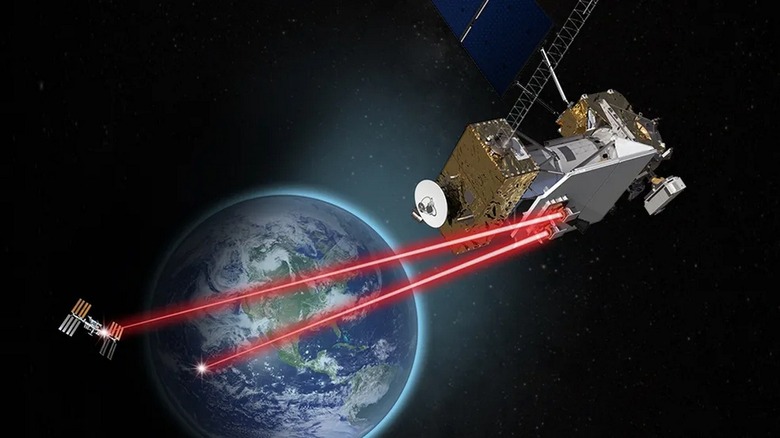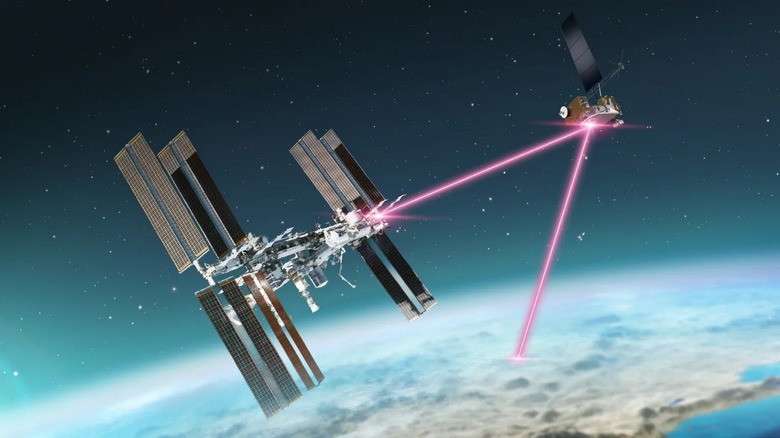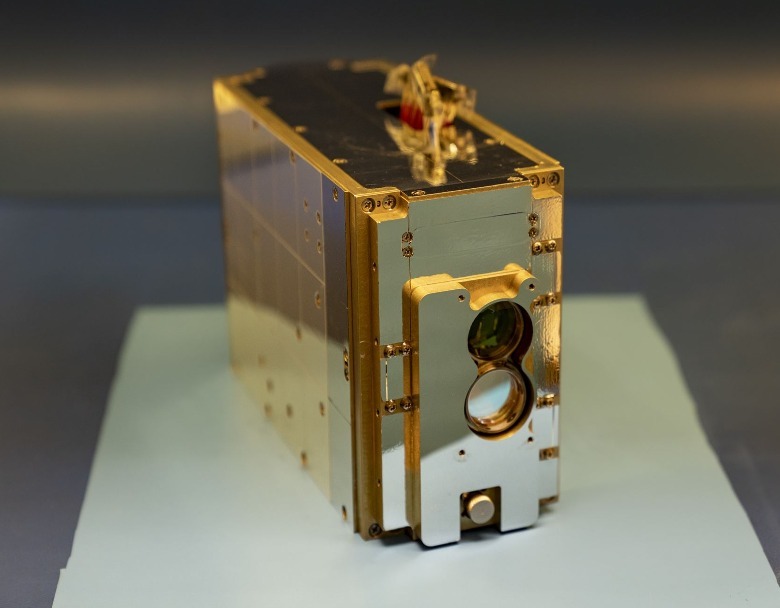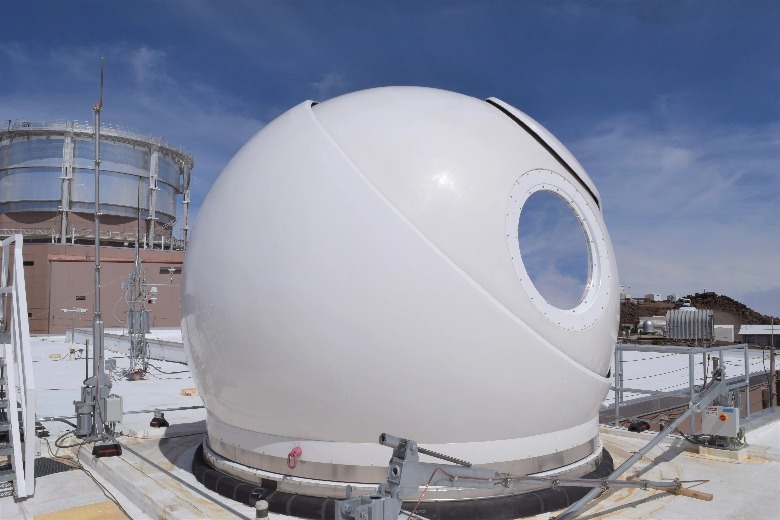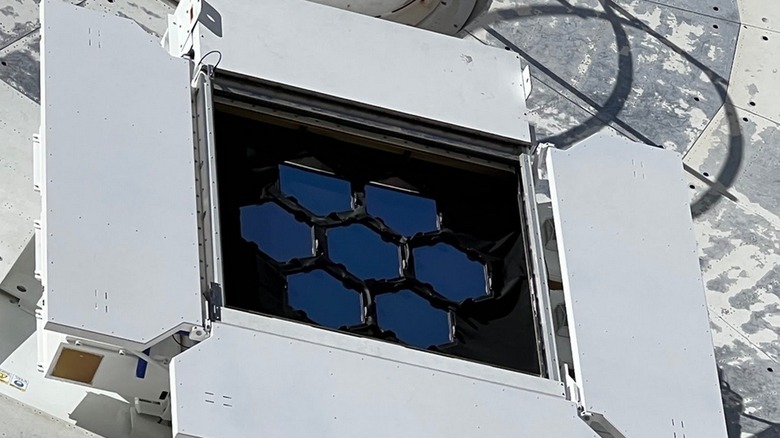Laser Transmission Explained: What It Means For Transmitting Data During Space Exploration
The world of science fiction is obsessed with lasers, but real scientists are not too far behind with that tech in real life, deploying it everywhere from watching cellular reactions to attempting Sun-like fusion on Earth. However, the denizens of Earth need lasers to voyage into the depths of space and demystify what's out there. Unfortunately, with existing communication tech, those lofty goals won't be possible. Take for example the Voyager probe, which was launched in 1977, and currently floats in interstellar space.
As it parked in Jupiter's backyard, it reached a maximum transmission rate of just over 100 kbps, and right now, the numbers stand at just over 160 bps. Establishing a one-way link from Earth to the probe takes nearly a day. To say that it's excruciatingly slow would be an understatement, especially in an era when certain billionaires are making rockets that claim to travel to other star systems. Even if we are talking about space exploration and being realistic about mankind's interplanetary colonization dreams, faster, high-bandwidth communication is necessary.
Deep space laser communication is a way of sending information wirelessly between spacecraft exploring deep space and stations on Earth. It uses lasers to carry electrical signals containing vital information like pictures, videos, and sound files. Communicating with lasers provides several advantages, such as allowing for faster data transfer rates, higher reliability with connections, and more flexible networking options. More crucially, laser communication equipment is small, lightweight, and uses a smaller amount of power compared to radio.
How does laser transmission work?
Laser communications use infrared light instead of radio waves. Since infrared light has a much higher frequency, way more data can be encoded per second. This enables a "space broadband" that supports missions needing to send massive amounts of data, like detailed imagery and scans of planets and moons. Lasers allow for the transmission of 100 to 1,000 times more data than current radio systems — like switching from dial-up to broadband internet.
Another benefit is that laser transmitters and receivers are way smaller and lighter than huge radio antennas, which is crucial for reducing launch costs and increasing flexibility for spacecraft. Lasers also require less power, since the beam doesn't spread out and waste energy like radio waves. This efficiency means smaller batteries and solar panels, which is very important for human exploration missions. Take for example the Lunar Lasercomm Space Terminal (LLST) aboard the LADEE vehicle: The laser communication system has a small 4-inch telescope and the entire kit is fairly lightweight at only 65 pounds.
Laser beams are also much harder to intercept or jam than radio signals, making them more secure. As we develop more advanced instruments capturing high-resolution data, have more remotely-controlled experiments, and explore deeper into space, this high data rate capability will be essential. Finally, they also solve the congestion problem. There are now thousands of new satellites being launched into space, and they all need to use different radio wave frequencies. Laser communications don't use radio waves, and therefore, they avoid the overcrowding situation.
NASA's work with laser communication
NASA has historically put its faith in radio waves for communicating with spacecraft, but as we need to send more and more data like high-resolution images and videos, radio waves are becoming strained. Unlike how we upgraded from dial-up to high-speed fiber internet on Earth, there hasn't been a similar jump in data transmission rates for spacecraft communications since the 1950s.
The space agency has, however, been exploring optical communications or laser transmissions for years, but it was only in 2013 that the first proven breakthrough arrived. In October of that year, the Lunar Laser Communication Demonstration (LLCD) system, flying aboard the Lunar Atmosphere and Dust Environment Explorer (LADEE) satellite, transmitted data from the lunar orbit to a station on Earth at a pace of 622 Mbps.
It was the first technical evidence that high-rate, error-free, two-way laser communication is feasible. The upload speeds, peaking at 20Mbps, weren't as high. Notably, the image transmitted from the terrestrial station was a grayscale digital copy of "The Mona Lisa" painting, but future tests will include pet media, as well.
Transmitting information between NASA's Jet Propulsion Laboratory's Optical Communications Telescope Laboratory in California to a floating computer in the lunar orbit approximately 239,000 miles away was no small achievement. Back then, it was the longest two-way laser-based communication ever established. This was followed by the Optical Payload for Lasercomm Science (OPALS) experiment in 2014.
Key milestones with laser transmission technology
The LLCD success was a key milestone, but more than fast transmission, it demonstrated another technical victory. Compared to a similar radio communication system, the laser communication equipment was only half as heavy and required much less power, using only about 75% as much energy. This was followed by NASA's Laser Communications Relay Demonstration (LCRD) in 2021, which is the agency's first end-to-end laser communications relay system that is capable of transmitting data at a rate of 1.2 gigabits per second.
Meanwhile, in 2022, researchers detailed a special kind of laser made using the enigmatic Bose-Einstein Condensate (BEC), a unique state of matter, that takes advantage of atomic motion acting as waves. The system is essentially a matter-based laser that will theoretically last forever. A year later, NASA's LCRD achieved its first data exchange link with the ILLUMA-T (Integrated LCRD Low Earth Orbit User Modem and Amplifier Terminal) system on the space station. The data exchange pace between the two now stands at over 1 Gbps.
The same year, the 25-pound TeraByte InfraRed Delivery (TBIRD) payload — which is part of NASA's Pathfinder Technology Demonstrator program — demonstrated transmission rates close to 100 gigabits per second from the orbit. In April of 2024, the Deep Space Optical Communications (DSOC) kit on the asteroid-bound Psyche spacecraft successfully sent data packets from roughly 140 million miles away at a rate of about 25 Mbps.
That number might sound small, but it's still "10 to 100 times faster than the state-of-the-art radio frequency systems used by deep space missions today," according to NASA. When the Psyche spacecraft is at its maximum distance from Earth, it will take around 20 minutes for the laser communication system's signals to make the journey back to our planet.
The future ahead for laser communication
Earlier this year, NASA also did a successful test of the Deep Space Station 13 experimental antenna by tracking laser signal from the Deep Space Optical Communications (DSOC) system. This antenna is special, as it can receive both radio as well as laser signals. Thankfully, the future holds more potential. As part of the Artemis II mission, Orion Artemis II Optical Communications System (O2O) will lay the foundations of laser-based communication on the Moon's surface and it is expected to launch towards the end of 2024. "At 260 megabits per second, O2O is capable of sending down 4K high-definition video from the Moon," says project manager Steve Horowitz.
In addition to sending media assets, the O2O system will enable the exchange of other critical data between the Orion spacecraft and Earth, such as operational procedures, imagery, flight planning information, communications, and voice communications. Reliant on a 4-inch telescope, the O2O module will also mark the first time that laser communication will be deployed for a crewed spaceflight mission.
The O2O (Orion Artemis II Optical Communications System) terminal will facilitate the transmission of ultra-high-definition video footage via infrared light signals, providing an unprecedented visual link between Earth and the Artemis II astronauts as they orbit the Moon. In the year 2026, NASA's Psyche mission will reach its celestial target – an asteroid situated a staggering 150 million miles from Earth. Carrying the DSOC payload, it will test laser communication capabilities against the challenges posed by deep space exploration.
